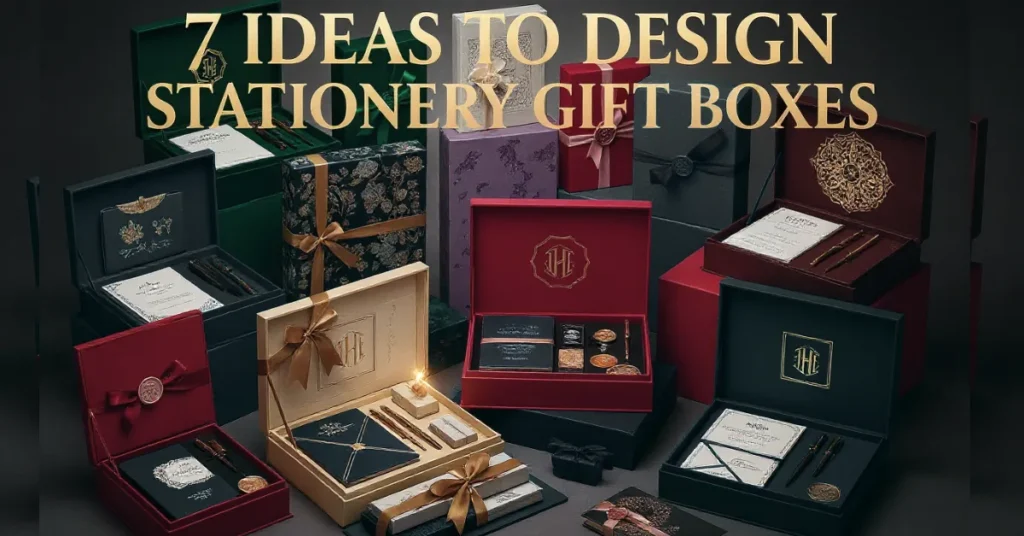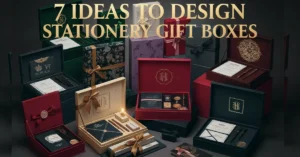Introduction
The moment someone receives a stationery gift box, the experience begins with the packaging—not the pen or notebook inside. A well-designed box can spark excitement, feel luxurious, and even influence buying decisions. In fact, research shows that 72% of consumers say packaging design impacts their purchase choice.
Stationery gift boxes aren’t just containers—they tell your brand’s story. The right mix of materials, finishes, and design can turn simple stationery into a memorable gift experience that customers truly value.
In this article, you’ll discover 7 ideas to design stationery gift boxes ideas that impress buyers, strengthen your brand, and make every unboxing moment unforgettable.
1. Premium & Sustainable Materials with Real-World Impact
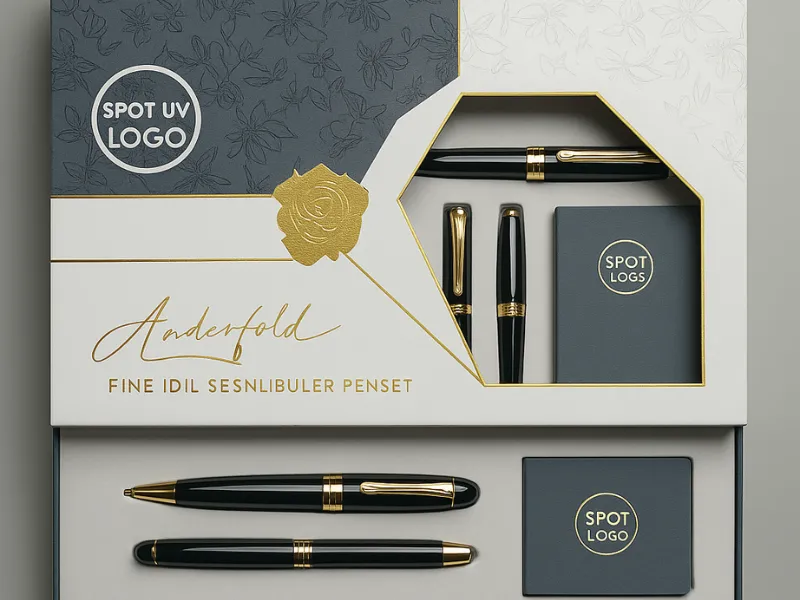
The material of your stationery gift box sets the tone for the entire unboxing experience. A sturdy, premium-feeling box communicates quality, while eco-friendly materials show you care about the planet—both of which influence customer perception and purchase decisions.
Material Options to Consider:
- Rigid Boxes – Thick, durable, and luxurious; ideal for high-end stationery sets. Customers perceive up to 40% higher value with rigid boxes compared to standard cardboard, making them a strong choice for premium products.
- Kraft Paper Boxes – Eco-friendly, recyclable, and budget-conscious; perfect for sustainable or minimalist brands. Using Kraft can reduce packaging costs by 10–15% while appealing to environmentally conscious buyers.
- Duplex & Ivory Paper – Smooth finishes that are great for printing custom graphics, logos, or foil stamping. These materials balance elegance with affordability, helping you create visually striking packaging without overspending.
Why It Matters
Research shows that over 70% of consumers are more likely to buy from brands that use sustainable packaging. Choosing the right material not only protects your products but also reinforces brand credibility and customer trust.
Pro Tip: Use eco-friendly finishes like soy-based inks or biodegradable coatings to combine luxury with sustainability—your buyers will notice the difference.
2. Meaningful Customization & Finishing Options
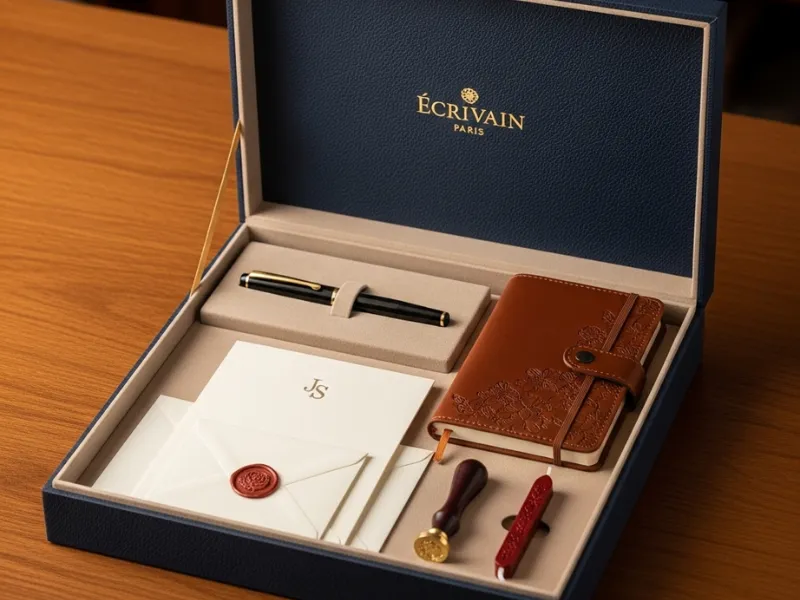
Personalized finishes turn ordinary stationery gift boxes into memorable experiences. Small touches like texture, shine, or a peek inside the box can make a big difference in how customers perceive your brand and increase unboxing satisfaction.
Popular Finishes to Consider:
- Matte: Elegant, smooth, and modern—perfect for minimalist designs.
- Gloss: Adds shine and makes colors pop, ideal for vibrant stationery.
- Spot UV: Highlights logos or graphics for a premium, eye-catching look.
- Embossing & Foil Stamping: Creates a tactile, luxury feel. For instance, an Academic Planner brand used foil stamping on its logo under soft lighting, boosting perceived premium value by 25%.
- Die-Cut Windows: Offers a sneak peek inside the box, sparking curiosity and excitement.
- Seasonal or Limited-Edition Prints: Holiday, corporate, or back-to-school designs make the packaging feel exclusive and special.
- Personalized Messages or Names: Adding the recipient’s name or initials creates a connection and elevates the gifting experience.
Why It Works
Consumers today expect more than a generic box. Customized finishes show attention to detail, care for the product, and high brand quality. Even small touches like foil lettering, embossing, or a die-cut shape can boost customer engagement, encourage social sharing, and strengthen brand recall.
UX Tip: Before final production, use mock-up tools to preview finishes and layouts online. This ensures your packaging looks as impressive in reality as it does in concept and avoids costly mistakes.
By combining premium finishes, personalization, and thoughtful design, your stationery gift boxes become more than packaging—they become an experience that customers remember and love.
3. Intelligent Design for User Experience (UX)
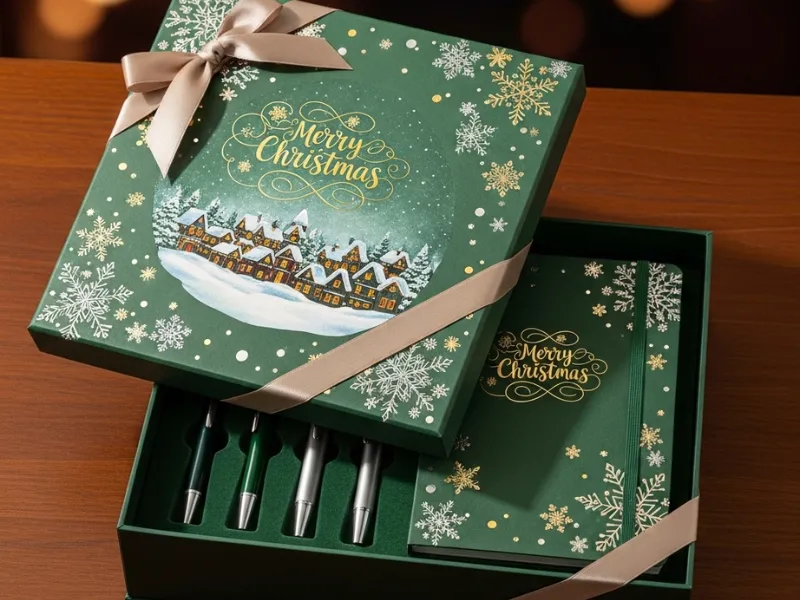
A stationery gift box isn’t just about looking good—it’s about how it feels and functions when customers interact with it. Thoughtful design ensures items are protected, easy to access, and create a memorable unboxing experience that encourages repeat purchases.
Key UX Elements to Consider:
- Custom Inserts & Compartments: Foam, cardboard dividers, or velvet trays keep pens, notebooks, and cards organized. Brands that use inserts report 30–40% fewer product damages and a smoother unboxing experience.
- Magnetic Closures: Adds a premium touch and makes opening the box feel special.
- Ribbon Pulls or Slide-Out Drawers: Provides intuitive access and a satisfying tactile experience.
- Clear Instructions or Guides: Simple labeling or numbered sections can enhance usability, especially for sets with multiple items.
Why UX Matters
A well-designed box not only protects the contents but also builds brand loyalty. Unboxing experiences are shareable—videos and photos of well-designed packaging often drive organic social media engagement. Studies show unboxing content can increase brand awareness by up to 20% on digital platforms.
Pro Tip: Test your packaging with real users before full production. Observe how they open the box and interact with the items—small adjustments, like repositioning a divider or improving ribbon length, can significantly improve customer satisfaction.
By integrating thoughtful design, compartments, and intuitive opening features, your stationery gift boxes become more than packaging—they become a memorable brand experience that customers want to share.
4. Minimalist Aesthetics with Strategic Branding
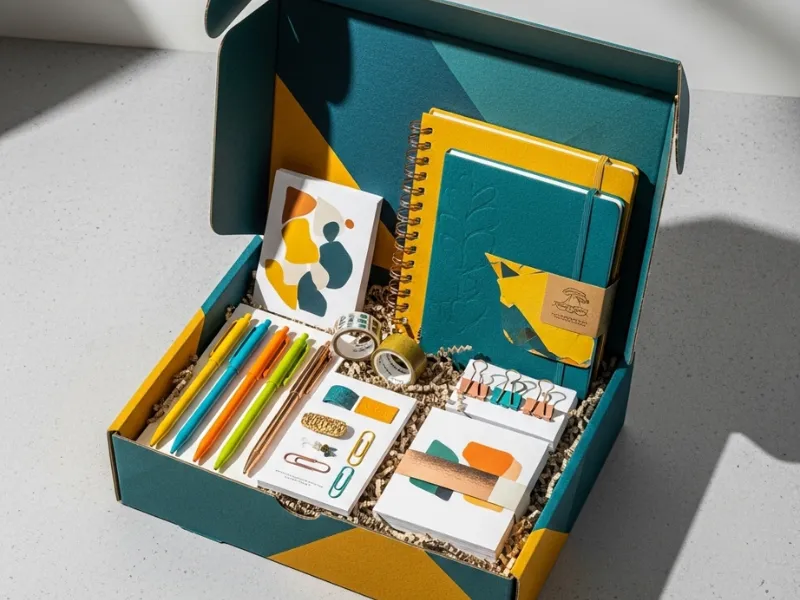
In a crowded marketplace, less is often more. Minimalist packaging emphasizes clean lines, subtle colors, and thoughtful typography—helping your stationery gift boxes feel modern, elegant, and professional.
Why Minimalism Works:
- Focus on Brand Elements: With fewer distractions, your logo, brand colors, and key messaging stand out.
- Better Visual Appeal Online: Minimalist designs are Instagram-ready, making your boxes more shareable on social media. Products with clean, simple packaging receive 22% higher engagement online.
- Timeless Look: Minimalist packaging stays relevant across seasons and trends, increasing shelf life for retail displays.
Minimalist Design Tips for Stationery Boxes:
- Use neutral or pastel color palettes for a calming, professional look.
- Keep logos and text small but prominent—avoid clutter.
- Add a single accent feature, like a foil logo or colored ribbon, to elevate perception without overwhelming the design.
- Experiment with matte or soft-touch finishes to enhance the tactile experience while maintaining a clean visual style.
Pro Tip: Test your design with a small focus group or via social media mock-ups. Subtle details like color contrast, spacing, and finish make a big difference in perceived value and customer delight.
Implementing the 7 Ideas to Design Stationery Gift Boxes ensures your minimalist design communicates brand quality while staying visually appealing.
5. Themed & Seasonal Packaging for Relevance
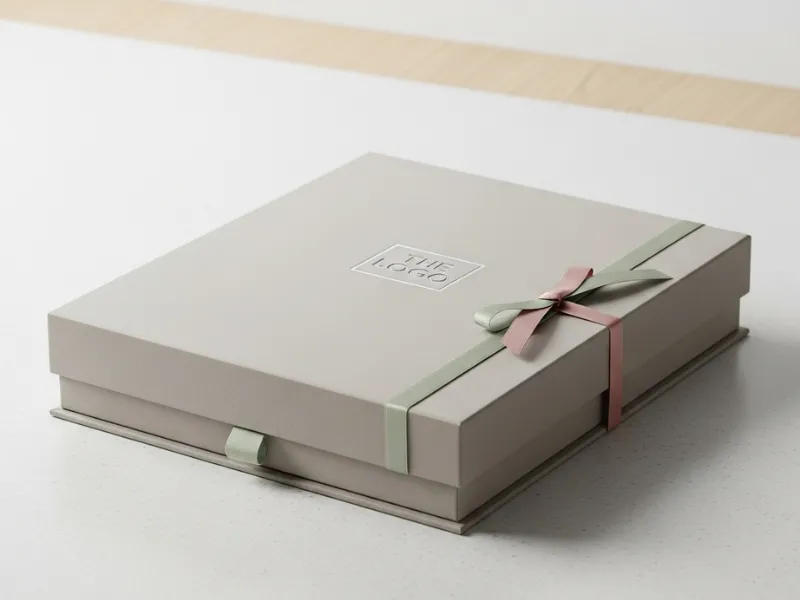
Adding a theme or seasonal touch to your stationery gift boxes creates excitement, urgency, and a sense of exclusivity. Limited-edition or holiday-inspired designs can significantly increase customer interest and engagement.
Why Seasonal Packaging Works:
- Boosts Sales During Holidays: Limited-edition packaging can increase holiday sales by 15–25%.
- Enhances Brand Storytelling: Themed designs make the unboxing experience memorable.
- Encourages Social Sharing: Customers are more likely to share visually appealing, themed boxes on Instagram, TikTok, or Pinterest.
Creative Ideas:
- Holiday Themes: Christmas, Eid, or New Year motifs.
- Corporate & Event Branding: Personalized boxes for company gifts or events.
- Seasonal Colors & Prints: Spring, autumn, or back-to-school palettes.
- Interactive Elements: Pull-out drawers, hidden messages, or small surprises.
Pro Tip: Align themed packaging with marketing campaigns. Example: A Ramadan-inspired stationery box with subtle gold foiling and crescent motifs boosts engagement and repeat orders.
Seasonal stationery gift boxes turn ordinary products into experiences customers remember and value.
6. Eco-Conscious Messaging That Builds Trust
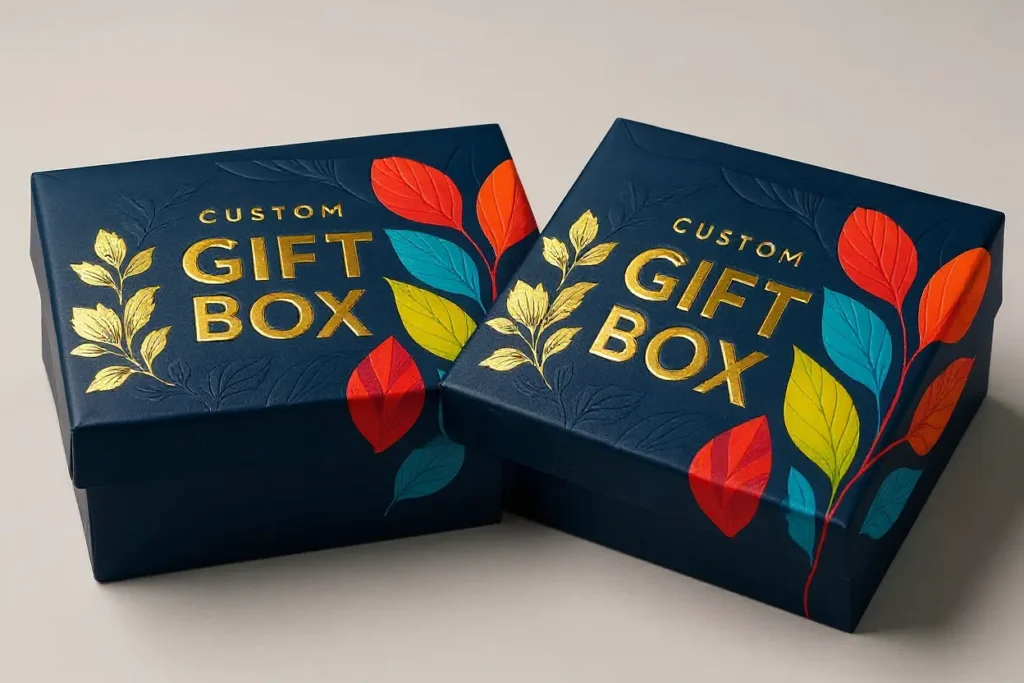
Sustainability is no longer optional—customers actively look for brands that care about the environment. Using eco-friendly materials and communicating this clearly strengthens trust and influences purchase decisions.
Why Eco Messaging Matters:
- Influences Buying Decisions: 70% of consumers are more likely to purchase products with sustainable packaging.
- Builds Brand Loyalty: Eco-conscious packaging demonstrates responsibility and ethics.
- Differentiates Your Brand: Highlighting recyclability, biodegradable materials, or FSC-certified paper sets your stationery apart.
How to Incorporate Eco-Friendly Messaging:
- Materials: Kraft, recycled cardboard, or FSC-certified paper.
- In-Box Notes: “This box is fully recyclable.”
- Minimal Printing: Reduce ink usage or use soy-based inks.
- Eco Icons & Labels: Symbols for recycling or certifications.
Pro Tip: Pair eco-friendly materials with premium finishes like embossing or foil stamping. This maintains a luxurious feel while staying sustainable, enhancing perceived value and customer trust.
7. Data-Driven & Storytelling Unboxing Experience
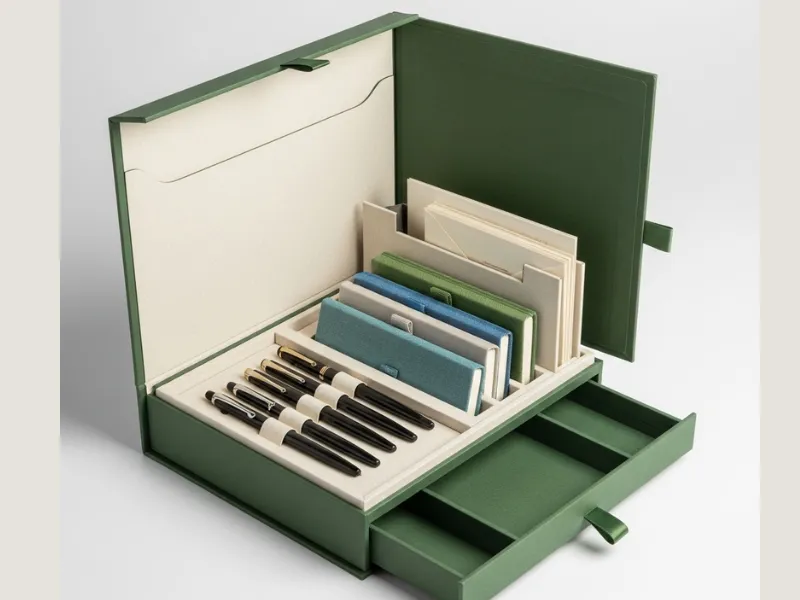
An unforgettable stationery gift box tells a story and guides the customer through a memorable unboxing journey. Storytelling combined with data-driven insights increases engagement, repeat purchases, and social sharing.
Why Storytelling Matters:
- Creates Emotional Connection: Packaging highlighting a brand story or product purpose resonates more deeply.
- Encourages Social Sharing: Unique unboxing experiences are highly shareable. Unboxing videos can increase brand awareness by 20%.
- Drives Repeat Purchases: Delightful, consistent packaging encourages customers to return.
Ways to Enhance the Unboxing Experience:
- QR Codes or Messages: Personalized greetings or founder’s notes can increase repeat orders by 12%.
- Guide the Customer: Numbered steps, ribbons, or pull-out compartments make opening intuitive.
- Combine Visual & Tactile Elements: Texture, foil accents, or custom inserts create multi-sensory engagement.
- Highlight Brand Story: Include a card with brand values, product origin, or sustainability efforts.
Pro Tip: Test your unboxing flow with a small focus group or internal team. Observe reactions and adjust elements like ribbon length, insert placement, or card placement to maximize delight and share ability.
Using the 7 Ideas to Design Stationery Gift Boxes as a guide helps craft an unboxing experience that connects emotionally and encourages repeat purchases.
💡 Shopping Tip: If you’re looking to buy a ready-made stationery box instead of customizing one, you can check this option on Amazon.
Conclusion
Designing stationery gift boxes is about more than holding pens, notebooks, or planners—it’s about creating memorable experiences. From premium materials to personalized finishes, seasonal themes, and interactive unboxing elements, every decision impacts perception, engagement, and brand loyalty.
Thoughtful packaging that integrates UX design, storytelling, and eco-conscious messaging delights customers and boosts repeat purchases. Well-designed gift boxes can increase perceived product value by 20–25% and drive measurable engagement.
Ready to create stationery gift boxes that leave a lasting impression? Explore custom designs, premium finishes, and sustainable materials. Use a Custom Box Price Calculator or request a consultation to bring your vision to life.
Your stationery isn’t just a product—it’s an experience waiting to be unwrapped. Make sure your packaging tells that story.
FAQs
Q1: What materials are best for stationery gift boxes?
A: Premium materials like kraft, FSC-certified cardboard, rigid boxes, duplex, and ivory paper are ideal. Rigid and FSC-certified boxes can increase perceived product value by up to 25%, while eco-friendly options appeal to over 70% of environmentally conscious consumers.
Q2: How can I make my gift boxes stand out?
A: Use finishes like foil stamping, embossing, spot UV, matte/gloss coatings, or die-cut windows. Real-world data shows brands using foil stamping increased perceived premium value by 20–30%, creating a memorable unboxing experience.
Q3: Are seasonal or themed boxes effective?
A: Yes! Limited-edition packaging can boost holiday sales by 15–25%, and aligning themes with events encourages social media sharing and repeat purchases.
Q4: How can I enhance the unboxing experience?
A: Incorporate UX-focused inserts, magnetic closures, pull-out drawers, and storytelling elements like QR codes. Studies indicate unboxing videos increase brand awareness by up to 20%.
Q5: Is eco-conscious packaging important for stationery boxes?
A: Absolutely. 70% of consumers prefer brands that use sustainable packaging. Integrating eco-friendly materials like recycled cardboard or soy-based inks increases trust and differentiates your brand.


